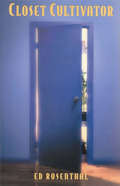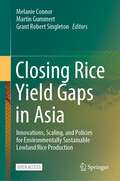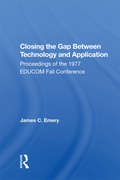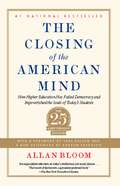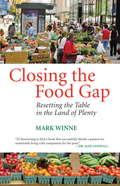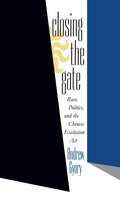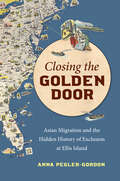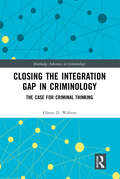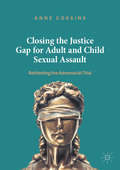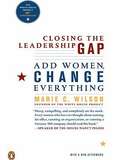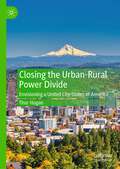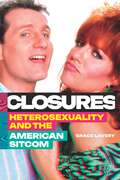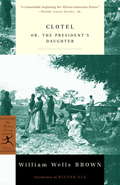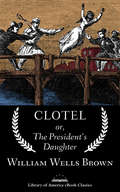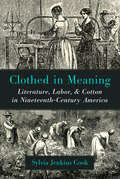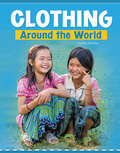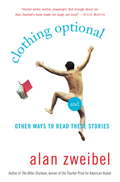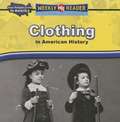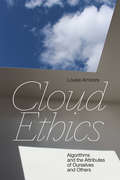- Table View
- List View
Closet Cultivator: Growing Marijuana Indoors
by Ed RosenthalWritten in clear, easy-to-understand language for the novice grower, Closet Cultivator is the ultimate secret growing guide. The author discusses lighting, nutrients, water systems, potency, and more, and he shows how to establish a high-yield garden in a limited space -- and on a limited budget.
Closet Queens: Some 20th Century British Politicians
by Michael BlochIn Closet Queens, masterful biographer Michael Bloch turns his attention to the men of British politics who were forced to lead double lives. Outwardly conforming to the requirements of heterosexual middle class society, many twentieth-century British politicians had illicit, clandestine and often thrilling queer sex lives. Some sought relationships with men of their own class, others with 'rough trade' and some confined themselves to fleeting, anonymous encounters in public places. After the Sexual Offences Act of 1967 decriminalised sexual acts in private between consenting males, the great fear of closet queens was not of prosecution in the courts but exposure in the press, leading some men to continue to repress their sexuality in order to realise their ambitions. Opening doors into the private, hidden worlds of key political figures in Britain, Closet Queens is an astonishing work that will be one of the talking points of 2015.
Closet Queens: Some 20th Century British Politicians
by Michael BlochCloset Queens is a fascinating study of gay men in twentieth century British politics, from Lord Rosebery and Lord Beauchamp in Edwardian times to Michael Portillo and Peter Mandelson in our own era. As all homosexual activity was illegal until 1967, and exposure meant ruin and disgrace, such men were obliged either to repress their sexual feelings or else lead double lives, indulging their tastes secretly while respectably married with children.The need to cover up their sexuality, while causing problems and disappointments, often sharpened their skills as politicians - they were masters of secrecy and subterfuge, and knew how to take calculated risks. An entertaining and insightful account of some extraordinary personalities, Closet Queens opens doors into a hidden world.
Closet Space: Geographies of Metaphor from the Body to the Globe (Critical Geographies Ser.)
by Michael P. BrownIs the closet just a metaphor? Closet Space provides a highly original account of the spatial metaphor of "the closet", and is the first geography text to focus on this important issue. Using a variety of research techniques and materials, the book explores the closet through texts including:* the oral histories of gay men in the UK and US* the sexualised landscape of a New Zealand city* the national census of Britain and the US* international travel guides and traveloguesand refers to the work of Butler, Lefebvre and Foucault.
Closing Rice Yield Gaps in Asia: Innovations, Scaling, and Policies for Environmentally Sustainable Lowland Rice Production
by Martin Gummert Melanie Connor Grant Robert SingletonThis open access book contributes not only to the scientific literature on sustainable agricultural development and in particular rice agriculture but also is highly valuable to assist practitioners, projects, and policymakers due to its sections on reducing carbon footprint, agricultural innovations, and lessons learned from a multi-country/multi-stages development project. The scope of the book is conceived as a detailed documentation of the implementation, dissemination, and impact of the CORIGAP project in Sri Lanka, Myanmar, Thailand, China, Vietnam, and Indonesia, with spill-over to Cambodia and the Philippines. It pulls together actionable research findings with the experience of bringing these findings into use. The aim of the book is to provide a wide array of pathways to impact for sustainable rice production in lowland irrigated rice-based agricultural systems. The book is written by local actors of the rice value chain, researchers, and engineers working on a range of best management practices, climate-smart rice production innovations, knowledge translation, and dissemination, as well as decision-making and policy aspects. It is envisioned that the contents of the book can be translated into messages that can help farmers, extension workers, policymakers, and funders of agricultural development, decide on implementing best management practices and climate-smart technologies in their agroecological systems by presenting the technological/practical options along the rice value chain and the partnerships and business models required for their implementation. The book is aimed at practitioners, extension specialists, researchers, and engineers interested in information on current best management practices, sustainable, and climate-smart rice production and constraints that need further investigation. Furthermore, the book is also aimed at policymakers and agricultural development funders required by public opinion and legally binding agreements to reduce greenhouse gas emissions, conserve biodiversity and increase agroecological practices, who are looking for research-based evidence to guide policymaking and implementation.
Closing The Gap Between Technology And Application
by James C. EmeryThis book presents analyses, from three points of view, of the use of computing technology in higher education. It considers application areas including office automation, distributed academic computing, distributed administrative computing, instructional systems, and information resources.
Closing of the American Mind: How Higher Education Has Failed Democracy and Impoverished the Souls of Today's Students
by Allan BloomThe Closing of the American Mind, a publishing phenomenon in hardcover, is now a paperback literary event. In this acclaimed number one national best-seller, one of our country's most distinguished political philosophers argues that the social/political crisis of 20th-century America is really an intellectual crisis. Allan Bloom's sweeping analysis is essential to understanding America today. It has fired the imagination of a public ripe for change.
Closing the Food Gap
by Mark WinneIn Closing the Food Gap, food activist and journalist Mark Winne poses questions too often overlooked in our current conversations around food: What about those people who are not financially able to make conscientious choices about where and how to get food? And in a time of rising rates of both diabetes and obesity, what can we do to make healthier foods available for everyone?To address these questions, Winne tells the story of how America's food gap has widened since the 1960s, when domestic poverty was "rediscovered," and how communities have responded with a slew of strategies and methods to narrow the gap, including community gardens, food banks, and farmers' markets. The story, however, is not only about hunger in the land of plenty and the organized efforts to reduce it; it is also about doing that work against a backdrop of ever-growing American food affluence and gastronomical expectations. With the popularity of Whole Foods and increasingly common community-supported agriculture (CSA), wherein subscribers pay a farm so they can have fresh produce regularly, the demand for fresh food is rising in one population as fast as rates of obesity and diabetes are rising in another. Over the last three decades, Winne has found a way to connect impoverished communities experiencing these health problems with the benefits of CSAs and farmers' markets; in Closing the Food Gap, he explains how he came to his conclusions. With tragically comic stories from his many years running a model food organization, the Hartford Food System in Connecticut, alongside fascinating profiles of activists and organizations in communities across the country, Winne addresses head-on the struggles to improve food access for all of us, regardless of income level. Using anecdotal evidence and a smart look at both local and national policies, Winne offers a realistic vision for getting locally produced, healthy food onto everyone's table.
Closing the Gate
by Andrew GyoryThe Chinese Exclusion Act of 1882, which barred practically allChinese from American shores for ten years, was the first federallaw that banned a group of immigrants solely on the basis of raceor nationality. By changing America's traditional policy of openimmigration, this landmark legislation set a precedent for futurerestrictions against Asian immigrants in the early 1900s andagainst Europeans in the 1920s. Tracing the origins of the Chinese Exclusion Act, AndrewGyory presents a bold new interpretation of American politicsduring Reconstruction and the Gilded Age. Rather than directlyconfront such divisive problems as class conflict, economicdepression, and rising unemployment, he contends, politicianssought a safe, nonideological solution to the nation's industrialcrisis--and latched onto Chinese exclusion. Ignoring workers'demands for an end simply to imported contract labor, theyclaimed instead that working people would be better off if therewere no Chinese immigrants. By playing the race card, Gyoryargues, national politicians--not California, not organizedlabor, and not a general racist atmosphere--provided the motiveforce behind the era's most racist legislation.
Closing the Golden Door: Asian Migration and the Hidden History of Exclusion at Ellis Island
by Anna Pegler-GordonThe immigration station at New York's Ellis Island opened in 1892 and remained the largest U.S. port for immigrant entry until World War I. In popular memory, Ellis Island is typically seen as a gateway for Europeans seeking to join the "great American melting pot." But as this fresh examination of Ellis Island's history reveals, it was also a major site of immigrant detention and exclusion, especially for Chinese, Japanese, and other Asian travelers and maritime laborers who reached New York City from Europe, the Americas and the Caribbean, and even within the United States. And from 1924 to 1954, the station functioned as a detention camp and deportation center for a range of people deemed undesirable. Anna Pegler-Gordon draws on immigrants' oral histories and memoirs, government archives, newspapers, and other sources to reorient the history of migration and exclusion in the United States. In chronicling the circumstances of those who passed through or were detained at Ellis Island, she shows that Asian exclusion was both larger in scope and more limited in force than has been previously recognized.
Closing the Integration Gap in Criminology: The Case for Criminal Thinking (Routledge Advances in Criminology)
by Glenn D. WaltersClosing the Integration Gap in Criminology: The Case for Criminal Thinking offers a multi -stage model of theory integration that organizes verified risk factors around the construct of criminal thinking to provide an exemplar working paradigm for criminology. In the model, once relevant risk factors have been identified, they are organized into triads —three-variable networks of antecedent, mediating, or moderating effects—and then those triads are combined into clusters of thematically related constructs. While debate continues to rage over how to handle the burgeoning number of theories in criminology, little significant progress has been made in reducing the number of criminological theories. This book argues that theoretical integration is vital to the continued viability of criminological theory and to the growth and development of criminology as a scientific discipline. It posits that criminal thinking may be useful as a core variable in constructing a useful integrated theory for criminology, and maps out a plan for scholars to organize information for further study. The innovative theoretical approach in this book is essential reading for students, academics, and researchers in both criminology and forensic psychology concerned with the reduction of crime via scientific inquiry.
Closing the Justice Gap for Adult and Child Sexual Assault: Rethinking the Adversarial Trial
by Anne CossinsThis book examines the justice gap and trial process for sexual assault against both adults and children in two jurisdictions: England and Wales and New South Wales, Australia. Drawing on decades of research, it investigates the reality of the policing and prosecution of sexual assault offences – often seen as one of the ‘hardest crimes to prosecute’ – across two similar jurisdictions. Despite the introduction of the many reform options detailed in the book, satisfactory outcomes for victims and the public are still difficult to obtain.Cossins takes a new approach by examining the nature and effects of adversarialism on vulnerable witnesses, jury decision-making and the structures of power within the trial process, to show how, and at what points, that process is weighted against complainants of sexual assault, in order to make evidence-based suggestions for reform. She argues that this justice gap is a result of a moralistic adversarial culture which fosters myths and misconceptions about rape and child sexual assault, thus requiring the prosecution to prove a complainant’s moral worthiness. She argues this culture can only be eliminated by a radical replacement of the adversarial system with a trauma-informed system. By reviewing the relevant psychological literature, this book documents the triggers for re-traumatisation within an adversarial trial, and discusses the reform measures that would be necessary to transform the sexual assault trial from one where the complainant’s moral worthiness is ‘on trial’ to a fully functioning trauma-informed system. It speaks to students and academics across subjects including law, criminology, gender studies and psychology, and practitioners in law and victim services, as well as policy-makers.
Closing the Leadership Gap
by Marie C. WilsonThe defining examination of the new role of women in America?now fully revised When first published in 2004, Marie Wilson?s Closing the Leadership Gap finally drew attention to what everyone knew but no one talked about?the lack of women in America?s leadership positions, even though compelling research shows that women enhance the top decision-making process dramatically. And yet, even as our nation sits on a world spinning with crises, we have barely begun to tap that most critical natural resource. With the possibility of America?s first woman president looming large, now is the time to revisit this inspiring call to action. .
Closing the Urban-Rural Power Divide: Envisioning a United City-States of America
by Thor HoganThis book proposes a radical reorganization of political and electoral power to address the current political imbalance between urban and rural populations in the United States. Hogan argues that, despite being smaller in population, a “financialist-ruralist coalition” has effectively used the Constitution—especially equal representation in the Senate—to create an anti-urban “vetocracy.” This political imbalance protects the interests of the financial elite and rural cultural conservatives, while effectively blocking urban interests, particularly regarding the adoption of a broad range of structural reforms and progressive policy preferences. By re-dividing many of the largest federated states into smaller city-states, the book posits, the United States would reduce the ability of non-urban interests to control the Senate. This would allow an empowered urbanite alliance to pass the forward-looking legislation the nation needs to remain internationally competitive in the coming decades.
Closures: Heterosexuality and the American Sitcom
by Grace LaveryFrom The Mary Tyler Moore Show to Arrested Development to BoJack Horseman, the American sitcom revolves around crises that must be resolved by episode’s end, with a new crisis to come next week. In Closures, Grace Lavery reconsiders the genre’s seven-decade history as an endless cycle of crisis and closure that formally and representationally frames heterosexuality as constantly on the verge of both collapse and reconstitution. She shows that even the normiest family-based sitcoms rely on queer characters like Alice (The Brady Bunch) and Steve Urkel (Family Matters) who highlight how the family is perpetually incomplete and unstable. Analyzing the genre’s techniques and devices such as the laugh track and the cringe pan, Lavery also charts the shift to friend-group and workplace sitcoms like Friends and The Office, which she contends reflect a weakening of social ties in ways that place characters in an unending state of becoming. With this capacious yet svelte queer and trans theorization of the sitcom, Lavery demonstrates that the family ties that bind the genre’s normative heterosexuality are far more tenuous than we have been led to believe.
Clotel Or, The President's Daughter
by William Wells BrownThe first novel published by an African American, Clotel takes up the story, in circulation at the time, that Thomas Jefferson fathered an illegitimate mulatto daughter who was sold into slavery. Powerfully reimagining this story, and weaving together a variety of contemporary source materials, Brown fills the novel with daring escapes and encounters, as well as searing depictions of the American slave trade. An innovative and challenging work of literary invention, Clotel is receiving much renewed attention today. William Wells Brown, though born into slavery, escaped to become one of the most prominent reformers of the nineteenth century and one of the earliest historians of the black experience. This Modern Library Paperback Classics edition reproduces the first, 1853, edition of Clotel and includes, as did that edition, his autobiographical narrative, "The Life and Escape of William Wells Brown," plus newly written notes.
Clotel; or, The President's Daughter: An African-american Life
by William Wells Brown<p>Born a slave and kept functionally illiterate until he escaped at age nineteen, William Wells Brown refashioned himself first as an agent of the Underground Railroad and then as an antislavery activist and self-taught orator and author, eventually becoming a foundational figure of African American literature. <p>His most ambitious work, Clotel; or, the President’s Daughter (1853), the first novel written by an African American, purports to be the history of Thomas Jefferson’s black daughters and granddaughters. Dramatizing the victimization of black women under slavery, the novel measures the yawning chasm between America’s founding ideals and the brutal realities of bondage.
Clothed in Meaning: Literature, Labor, and Cotton in Nineteenth-Century America (Class : Culture)
by Sylvia Jenkins CookThe rise of both the empire of cotton and the empire of fashion in the nineteenth century brought new opportunities for sartorial self-expression to millions of ordinary people who could now afford to dress in style and assert their physical presence. Millions of laborers toiling in cotton fields and producing cotton cloth in industrial mills faced a brutal reality of exploitation, servitude, and regimentation—yet they also had a profound desire to express their selfhood. Another transformative force of this era—the rise of literary publication and the radical extension of literacy to the working class—opened an avenue for them to do so. Cloth and clothing provide potent tropes not only for physical but also for intellectual forms of self-expression. Drawing on sources ranging from fugitive slave narratives, newspapers, manifestos, and mill workers’ magazines to fiction, poetry, and autobiographies, Clothed in Meaning examines the significant part played by mill workers and formerly enslaved people, many of whom still worked picking cotton, in this revolution of literary self-expression. They created a new literature from their palpable daily intimacy with cotton, cloth, and clothing, as well as from their encounters with grimly innovative modes of work. In the materials of their labor they discovered vivid tropes for formulating their ideas and an exotic and expert language for articulating them. The harsh conditions of their work helped foster in their writing a trenchant irony toward the demeaning reduction of human beings to “hands” whose minds were unworthy of interest. Ultimately, Clothed in Meaning provides an essential examination of the intimate connections between oppression and luxury as recorded in the many different voices of nineteenth-century labor.
Clothes Long Ago
by Tara Funk Katherine ScraperPeople made clothes long ago. Read to find out how these clothes were different from your clothes today.
Clothes Then and Now
by Tara Funk Vickey HeroldWhat have people used to make clothes? What types of clothes do people wear today? Read this book to learn how clothes have changed.
Clothing Around the World (Customs Around the World)
by Mary MeinkingSome people's closets are full of jeans and T-shirts. Some wear traditional outfits. It all depends on your custom! Explore what people in different parts of the world wear in this fun, engaging series that develops kids' understanding of our diverse global community and their place in it.
Clothing Optional: And Other Ways to Read These Stories
by Alan Zweibel"Garry, it's Alan. Look, I'm calling because I just felt the need to tell someone that I'm forty-four years old, and about an hour ago, for the first time in my life, I put suntan lotion on my ass. I'll explain later. Bye. " In Clothing Optional, Alan Zweibel offers a collection of laugh-out-loud personal narratives, essays, short fiction, dialogues, and even a few whimsical drawings. Zweibel first made a name for himself as one of the original writers for Saturday Night Live, but his career's humble beginnings included creating one-liners for Catskill comedians at seven dollars a pop. That experience is only one of the hysterically inspired anecdotes ("Comic Dialogue") in this quirky compilation. Zweibel confesses his first love, as a young Hebrew school student, for Abraham's wife, Sarah ("At this point, Sarah's husband had been dead for more than three thousand years-so, really, who would I be hurting?"); recounts the time he was sent to a nudist resort to write an article ("The fact that I brought luggage is, in itself, worthy of some discussion"); offers a touching tribute to Saturday Night Live writer and mentor Herb Sargent ("Herb was New York. But an older, more romantic New York that took place in black and white like the kind of TV I grew up on and wanted to be a part of someday"); and imagines a scenario in which Sergeant Joe Friday, the stiff, monotoned character from Dragnet, is inexplicably partnered with Snoop Dogg ("Damn, Friday. You gotta learn to chill. Take some free time and kick it with your boys") Every piece is punctuated with the same wit and insight that have come to define Zweibel's humor. Unhinged and hilarious, Clothing Optional is an unguided tour through the uniquely peculiar life and mind of a man who The New York Times said "has earned a place in the pantheon of American pop culture. " From the Hardcover edition.
Clothing in American History
by Dana Meachen RauCorrelated to the social studies curriculum, each title in How People Lived in America looks at one aspect of daily life and how it has changed through different periods of American history. Clear, descriptive writing helps young readers build vocabulary and reading comprehension, while historical photographs and illustrations work with the text to increase students' knowledge about the lives of earlier Americans.
Clothing the Poor in Nineteenth-Century England
by Vivienne RichmondIn this pioneering study Vivienne Richmond reveals the importance of dress to the nineteenth-century English poor who valued clothing not only for its practical utility, but also as a central element in the creation and assertion of collective and individual identities. During this period of rapid industrialisation and urbanisation formal dress codes, corporate and institutional uniforms and the spread of urban fashions replaced the informal dress of agricultural England. This laid the foundations of modern popular dress and generated fears about the visual blurring of social boundaries as new modes of manufacturing and retailing expanded the wardrobes of the majority. But a significant impoverished minority remained outside this process. Clothed by diminishing parish assistance, expanding paternalistic charity and the second-hand trade, they formed a 'sartorial underclass' whose material deprivation and visual distinction was a cause of physical discomfort and psychological trauma.
Cloud Ethics: Algorithms and the Attributes of Ourselves and Others
by Louise AmooreIn Cloud Ethics Louise Amoore examines how machine learning algorithms are transforming the ethics and politics of contemporary society. Conceptualizing algorithms as ethicopolitical entities that are entangled with the data attributes of people, Amoore outlines how algorithms give incomplete accounts of themselves, learn through relationships with human practices, and exist in the world in ways that exceed their source code. In these ways, algorithms and their relations to people cannot be understood by simply examining their code, nor can ethics be encoded into algorithms. Instead, Amoore locates the ethical responsibility of algorithms in the conditions of partiality and opacity that haunt both human and algorithmic decisions. To this end, she proposes what she calls cloud ethics—an approach to holding algorithms accountable by engaging with the social and technical conditions under which they emerge and operate.
